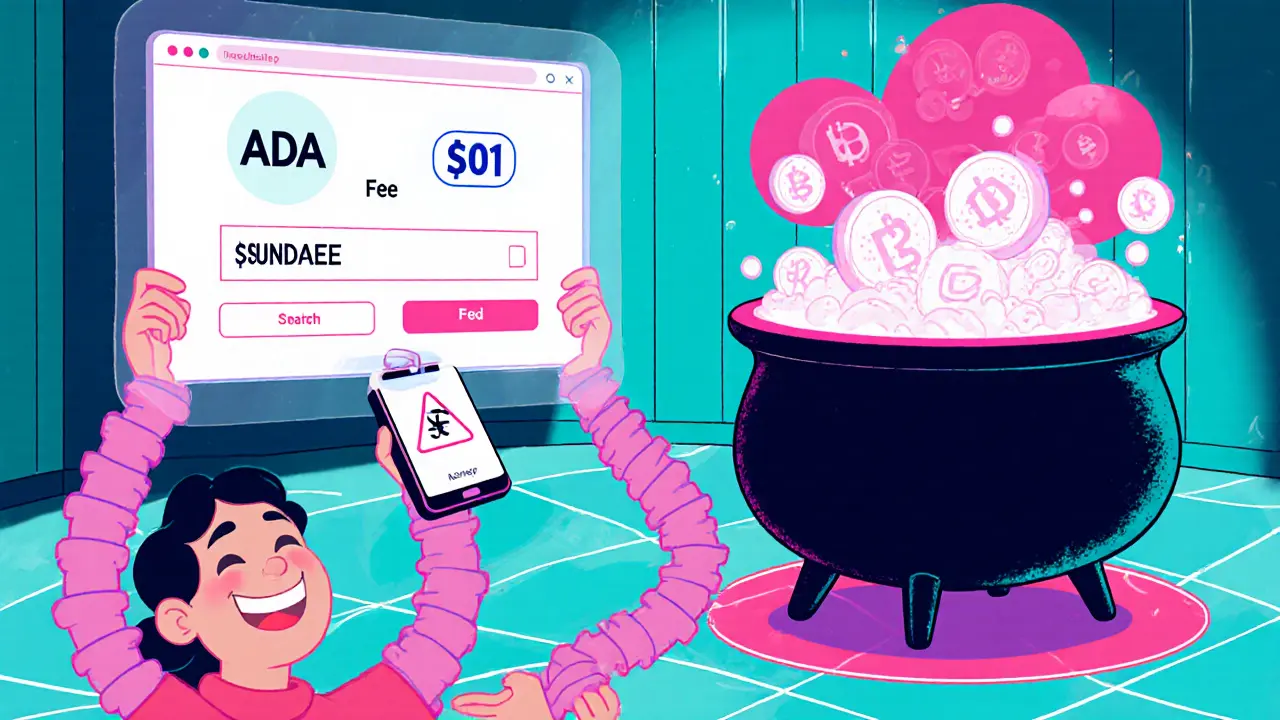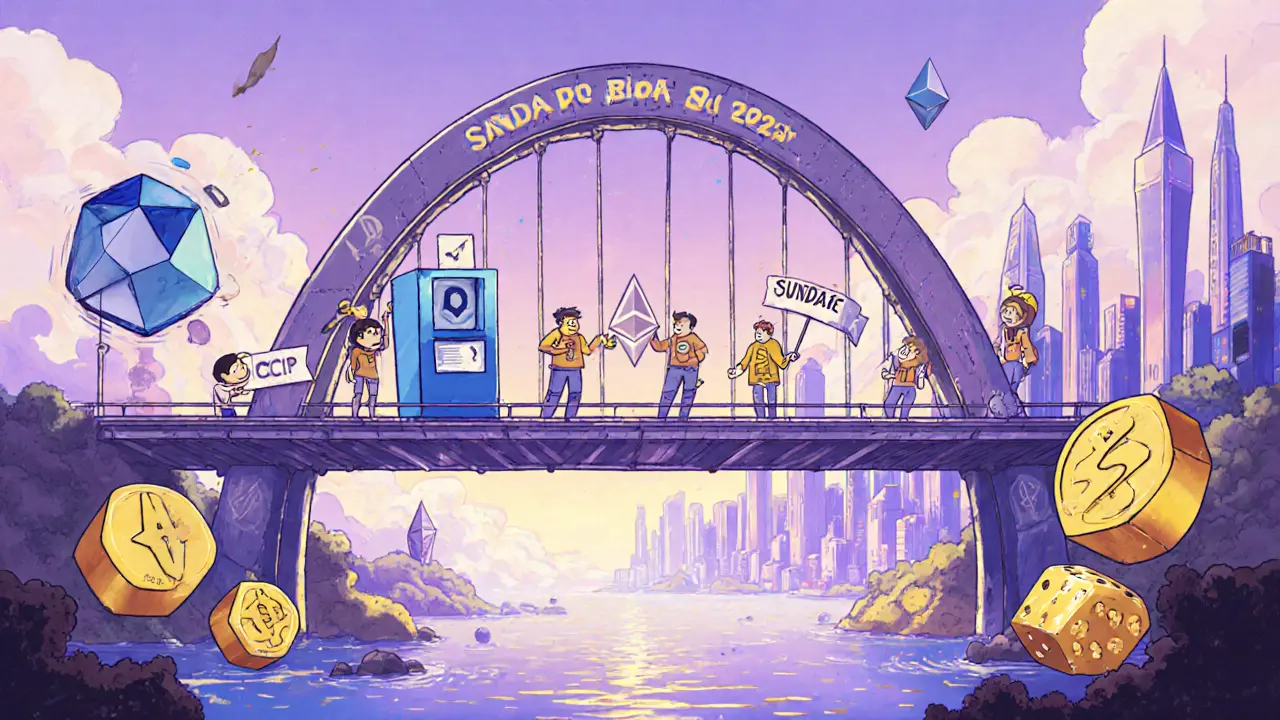SundaeSwap Review: In‑Depth Look at Cardano’s Leading DEX

Jan, 27 2025
SundaeSwap Swap Fee Calculator
Calculate Your Swap Fee
SundaeSwap fees are 0.2% of your trade value plus a minimal network fee under $0.01
Your Fee Breakdown
$0.00
Quick Takeaways
- SundaeSwap is the first and most mature DEX on Cardano, launched in 2021.
- Its TVL hovers between $7 M and $14 M, far smaller than Ethereum‑based giants but sizable for Cardano.
- Fees are typically under $0.01 per swap thanks to Cardano’s low‑cost architecture.
- Liquidity can dry up on niche token pairs, a common complaint among larger‑trade users.
- Roadmap promises cross‑chain bridges and derivatives by end‑2025, which could close the biggest gap with rivals.
If you’ve been scrolling through crypto forums looking for a Cardano‑only exchange, you’ve probably hit the name SundaeSwap review more than once. The platform has been billed as "the sweetest DEX on Cardano," but does it live up to the hype? This article breaks down the tech, the numbers, the user experience, and the risks so you can decide whether SundaeSwap belongs in your DeFi toolbox.
What is SundaeSwap?
SundaeSwap is a decentralized exchange (DEX) built specifically for the Cardano blockchain. Launched by SundaeSwap Labs in 2021, it went live on mainnet in early 2022 and has since become the go‑to spot market for native Cardano assets.
The platform runs on an Automated Market Maker (AMM) model that automatically matches buy and sell orders through liquidity pools. Governance is handled by the native $SUNDAE token, which lets holders vote on fee structures, new features, and protocol upgrades.
How does it work?
Cardano uses an extended UTXO (eUTXO) model, which is fundamentally different from Ethereum’s account‑based system. To make an AMM work on eUTXO, SundaeSwap introduced a "Scooper" architecture that bundles inputs and outputs into a single transaction, allowing swaps to settle in the typical 20‑second block time.
Liquidity providers (LPs) deposit paired assets-most commonly ADA and another native token-into a pool. In return they earn a share of the swap fees plus additional rewards paid in $SUNDAE. Because Cardano’s proof‑of‑stake consensus incurs negligible transaction costs, a typical trade on SundaeSwap costs under $0.01, compared with $0.10‑$0.30 on many Ethereum DEXs.
Core Features & Benefits
- Low fees: Cardano’s minimal gas means users keep more of their trade value.
- High security: Transactions inherit Cardano’s Ouroboros proof‑of‑stake guarantees, making the protocol resistant to many classic attacks.
- User‑friendly UI: The web interface is built for Cardano newcomers; the swap screen mirrors familiar centralized exchanges.
- Staking integration: LPs can simultaneously delegate ADA to stake pools, earning delegation rewards on top of swap fees.
- Open API: Developers can tap into swap data via REST endpoints for analytics or custom front‑ends.

Liquidity & TVL Snapshot
Liquidity is the lifeblood of any AMM. SundaeSwap’s Total Value Locked (TVL) has been volatile:
- August 2024: ~$14 million (Blockchain‑Ads.com)
- January 2025: ~$7 million (Koinly)
The dip reflects broader Cardano market swings and occasional large‑scale swaps that temporarily drain pools. Compared with Uniswap’s $4 billion+ TVL, SundaeSwap’s numbers are modest, but they represent roughly 38 % of Cardano‑DEX market share.
Getting Started: Wallets & First Swap
Because SundaeSwap is web‑based, the only technical requirement is a Cardano‑compatible wallet. The most popular choices are Nami, Eternl, and Flint. Setting up a wallet typically takes 10‑15 minutes, after which you can connect to SundaeSwap with a single click.
Reddit user u/CardanoTrader88 reported swapping $5,000 ADA for $SUNDAE and paying just $0.02 in fees. By contrast, u/DeFiNewbie2024 complained that trying to swap $1,200 worth of a low‑volume token resulted in a slippage error because the pool’s liquidity was insufficient.
Overall, most first‑time users spend about 25 minutes completing the onboarding flow, according to a Cardano Foundation user study (Jan 2025). The biggest hurdle is understanding how LP shares and impermanent loss work-68 % of newcomers seek help from community guides or the official Discord (average response time 22 minutes).
Comparison with Other Decentralized Exchanges
| Exchange | Primary Chain | TVL (USD) | Typical Swap Fee | Cross‑Chain Support |
|---|---|---|---|---|
| SundaeSwap | Cardano | $7 M‑$14 M | ≈$0.01 | No (roadmap for 2025) |
| Uniswap | Ethereum | $4 B+ | $0.20‑$0.30 | Yes (via bridges) |
| PancakeSwap | BNB Chain | $2 B+ | $0.07‑$0.12 | Limited |
| MuesliSwap | Cardano | ~$2 M | ≈$0.01 | No |
What this table shows is that SundaeSwap’s biggest advantage is cost, while its biggest weakness is liquidity and lack of cross‑chain capability. For users who only need to move ADA or other Cardano native tokens, it’s a solid choice. If you need stablecoin swaps or access to Ethereum‑based DeFi, you’ll likely hop to Uniswap or PancakeSwap.

Risks & Considerations
- Liquidity gaps: Smaller token pairs can suffer from high slippage or outright failed swaps.
- Ecosystem dependence: SundaeSwap’s growth is tightly tied to Cardano adoption. A slowdown in Cardano’s yearly user growth (target ~25 % YoY) could shrink TVL.
- Regulatory outlook: While Cardano follows global AML/KYC guidelines, the DEX itself is permissionless, meaning future regulations could affect bridge implementations.
- Technical maturity: The AMM’s eUTXO‑specific design is still relatively new. Bugs or upgrades could temporarily disrupt swaps.
Roadmap & Future Outlook
The official roadmap (Jan 2025) outlines three major milestones:
- Q2 2025 - Integration of cross‑chain functionality via the CCIP protocol, which would let users move assets between Cardano and Ethereum without leaving the UI.
- Q3 2025 - Enhanced governance features, including quadratic voting for $SUNDAE holders.
- Q4 2025 - Launch of derivatives trading (futures and options) on top‑level Cardano tokens.
Analysts at CoinLore predict a 33× price increase for $SUNDAE by 2030 if Cardano’s Hydra scaling solution rolls out on schedule (2026). Conversely, Mark Thompson of CoinCodex warns of a potential 25 % price dip if Cardano’s DeFi growth stalls below 15 % annually.
Verdict: Should You Use SundaeSwap?
If you’re already in the Cardano ecosystem-holding ADA, delegating to stake pools, or building Cardano‑based dApps-SundaeSwap is the natural entry point for on‑chain trading. Its ultra‑low fees and native wallet support make it beginner‑friendly, and the community‑driven governance adds a layer of transparency.
However, if you need deep liquidity for large‑volume trades, or you regularly juggle assets across multiple blockchains, you’ll likely hit a wall until the promised cross‑chain bridge arrives. Keep an eye on the Q2 2025 update; once that’s live, the platform’s appeal widens considerably.
Frequently Asked Questions
What wallets are compatible with SundaeSwap?
SundaeSwap works with any Cardano wallet that supports browser extensions, most notably Nami, Eternl, and Flint. Just install the extension, create or import your seed phrase, and click ‘Connect Wallet’ on the SundaeSwap site.
How are fees calculated on SundaeSwap?
Each swap incurs a flat protocol fee of 0.2 % plus a small network fee that usually stays below $0.01 thanks to Cardano’s low gas costs. Liquidity providers also receive a share of the fee pool.
Can I trade non‑Cardano tokens on SundaeSwap?
No. SundaeSwap only supports native Cardano assets (ADA and tokens minted on the Cardano chain). A cross‑chain bridge is slated for Q2 2025, which will change this limitation.
What is the $SUNDAE token used for?
$SUNDAE serves as the governance token. Holders can vote on fee structures, new pool listings, and upcoming protocol upgrades. The token is also distributed as a reward to liquidity providers.
Is SundaeSwap secure?
Security inherits Cardano’s proof‑of‑stake consensus and formal verification of smart contracts. The platform has undergone multiple audits, but as with any DeFi protocol, users should only invest what they can afford to lose.